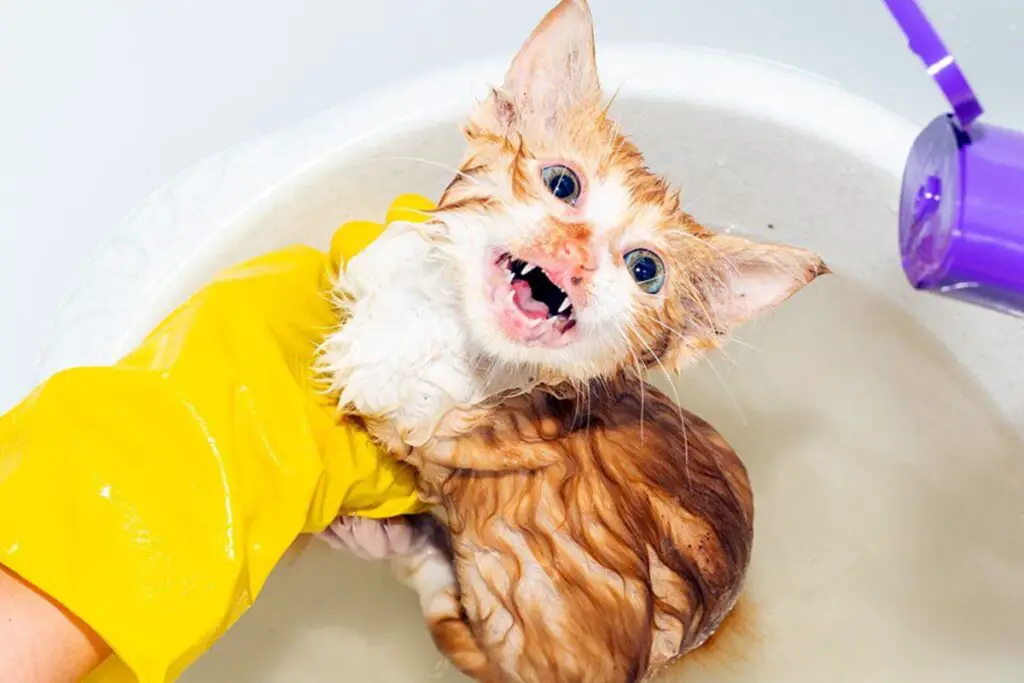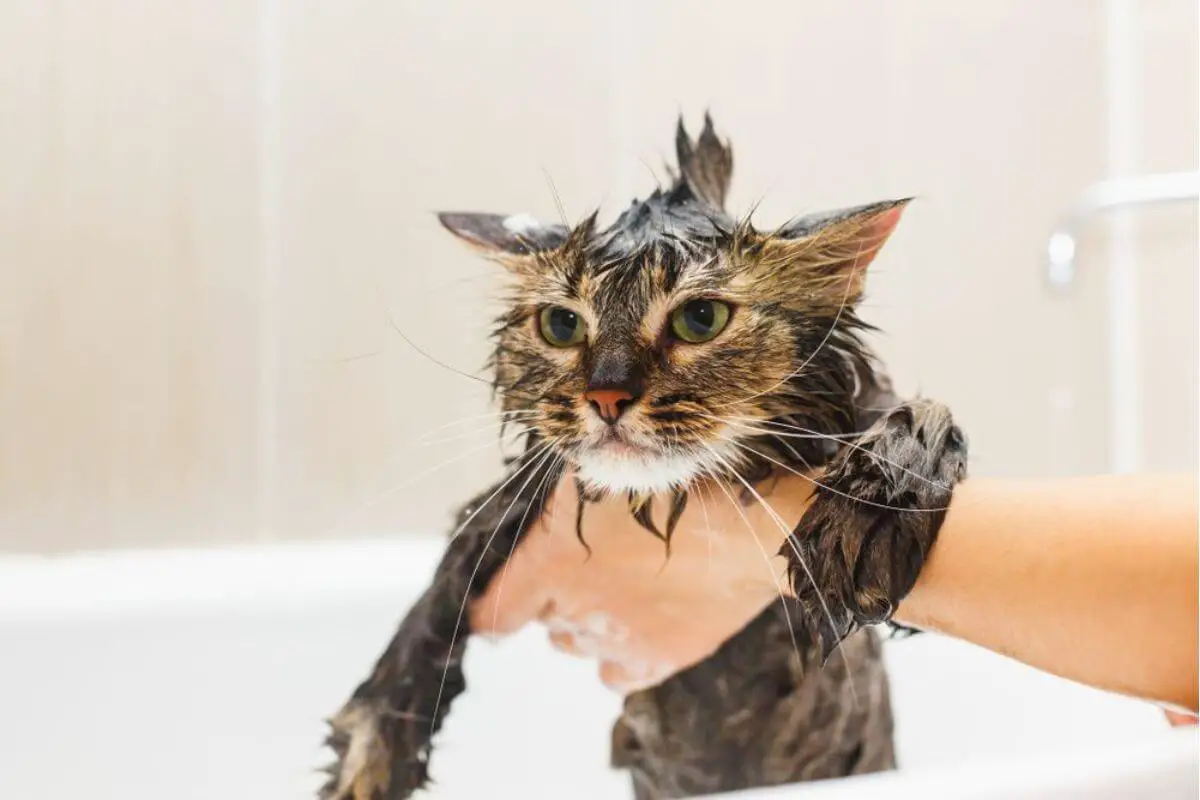Understanding the Post-Flea Treatment Bath for Cats:
After administering flea treatment to your feline friend, the question arises: can you bathe your cat afterward? Let’s explore the nuances of post-flea treatment baths to ensure your cat stays clean and comfortable without compromising the efficacy of the flea treatment.

**1. The Timing Dilemma:
Waiting Period After Treatment: Most flea treatments require a waiting period before allowing your cat to get wet. This waiting period varies, so it’s crucial to consult the specific product’s guidelines.
**2. Type of Flea Treatment:
Oral vs. Topical Treatment: Different flea treatments come in various forms, such as oral medications or topical solutions. The type of treatment administered can influence when it’s safe to bathe your cat.
**3. Guidelines from the Vet:
Customized Recommendations: Always adhere to the recommendations provided by your veterinarian. They can offer personalized advice based on your cat’s health, the chosen flea treatment, and any potential interactions with bathing.
Tips for a Stress-Free Post-Flea Treatment Bath:
**1. Choose Cat-Safe Shampoo:
Gentle Formulation: Opt for a cat-specific shampoo with a gentle formulation. This helps maintain the balance of natural oils on your cat’s skin while effectively addressing any residue from the flea treatment.
**2. Consider a Flea Treatment with Bathing Allowance:
Treatment Compatibility: Some flea treatments are formulated to withstand water exposure. If you anticipate frequent baths, discuss this with your veterinarian to choose a treatment that aligns with your cat’s lifestyle.
**3. Wait for the Ideal Temperature:
Comfortable Bathing Environment: Ensure the water temperature is comfortable for your cat. A lukewarm bath is preferable to prevent stress or discomfort.
**4. Gradual Introduction to Bathing:
Positive Reinforcement: If your cat is not accustomed to bathing, introduce them gradually. Associate the experience with positive reinforcement through treats and gentle praise.
Post-Bath Monitoring and Considerations:
**1. Observation for Adverse Reactions:
Vigilance is Key: Monitor your cat for any signs of irritation, discomfort, or adverse reactions post-bath. If any concerns arise, consult your veterinarian promptly.
**2. Drying Techniques:
Gentle Drying Process: Use a gentle towel to dry your cat thoroughly. If they tolerate it well, you can use a low-heat setting on a pet-friendly hairdryer. Ensure they are kept warm throughout the drying process.
Conclusion:
Bathing your cat after flea treatment requires careful consideration of the type of treatment, waiting periods, and your cat’s individual preferences. By following the guidelines provided by your veterinarian and choosing cat-safe products, you can maintain a clean and comfortable environment for your feline companion.
Additional Considerations for Post-Flea Treatment Cat Care:
**5. Frequency of Baths:
Balancing Hygiene and Treatment: While some cats tolerate baths well, others may find the experience stressful. Consider the frequency of baths based on your cat’s needs and preferences, ensuring it aligns with the guidelines of the chosen flea treatment.
**6. Alternative Cleaning Methods:
Grooming as an Option: If your cat despises baths, explore alternative cleaning methods. Regular grooming sessions with a cat-friendly brush can help remove excess fur and distribute natural oils, reducing the need for frequent baths.
**7. Environmental Flea Control:
Comprehensive Approach: In addition to topical or oral flea treatments, consider implementing environmental control measures. Vacuuming, washing bedding, and using flea preventatives in the living space contribute to a comprehensive flea management plan.
**8. Collaboration with a Professional Groomer:
Expert Assistance: If your cat is particularly challenging when it comes to baths, consider seeking assistance from a professional groomer. They have the expertise to handle cats with various temperaments and can ensure a stress-free grooming experience.
Post-Bath Enrichment and Rewards:
Positive Associations: To create positive associations with baths, engage in post-bath playtime or offer your cat a favorite treat. This helps reinforce positive feelings and reduces anxiety associated with bathing.
Final Thoughts on Post-Flea Treatment Cat Baths:
Bathing your cat after flea treatment requires a thoughtful approach that considers your cat’s well-being, the type of flea treatment used, and their individual temperament. By incorporating alternative cleaning methods, collaborating with professionals when needed, and creating positive associations with baths, you can strike a balance between maintaining a flea-free environment and ensuring your cat’s comfort.
Remember, each cat is unique, and what works for one may not work for another. Pay attention to your cat’s cues, consult your veterinarian for tailored advice, and make the post-flea treatment bath experience as positive and stress-free as possible.
Frequently Asked Questions (FAQs) About Post-Flea Treatment Cat Baths:
1. Can I bathe my cat immediately after applying flea treatment?
Answer: It depends on the specific flea treatment. Some products require a waiting period before allowing your cat to get wet. Refer to the product’s guidelines or consult your veterinarian for precise instructions.
2. What should I do if my cat hates baths?
Answer: If your cat dislikes baths, consider alternative cleaning methods such as regular grooming with a cat-friendly brush. Professional groomers can also provide assistance, ensuring a stress-free experience.
3. How often should I bathe my cat after flea treatment?
Answer: The frequency of baths depends on your cat’s tolerance and the chosen flea treatment. Some cats may only need occasional baths, while others may require more frequent cleaning. Consult your veterinarian for personalized advice.
4. Are there specific shampoos I should use for post-flea treatment baths?
Answer: Choose cat-specific shampoos with gentle formulations. Ensure the shampoo is compatible with the flea treatment used and does not compromise its effectiveness.
5. Can I use a hairdryer on my cat after a bath?
Answer: If your cat tolerates it well, you can use a low-heat setting on a pet-friendly hairdryer. However, always prioritize your cat’s comfort, and if they show signs of distress, opt for gentle towel drying.
6. Are there alternatives to bathing for post-flea treatment care?
Answer: Yes, grooming with a cat brush is an alternative to bathing. Regular cleaning of your cat’s fur can help distribute natural oils and reduce the need for frequent baths.
7. What environmental measures can I take for flea control?
Answer: Implement comprehensive environmental control measures, including regular vacuuming, washing bedding, and using flea preventatives in your home. This complements the effectiveness of topical or oral flea treatments.
8. How can I create positive associations with baths for my cat?
Answer: Engage in post-bath playtime or offer treats to create positive associations. Reinforcing positive experiences helps reduce anxiety associated with bathing.
Feel free to reach out if you have additional questions or require further clarification on post-flea treatment cat baths.



